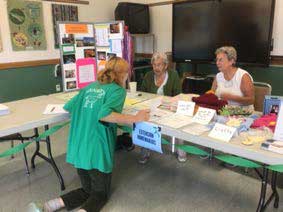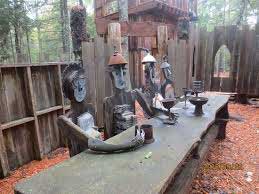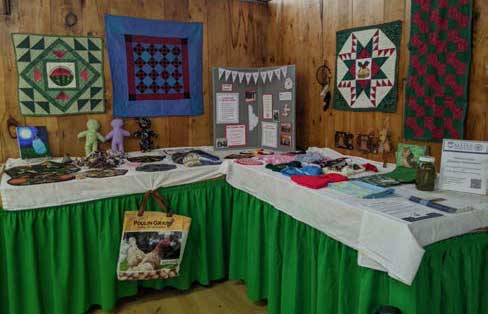
Maine Extension Homemakers Newsletter, Fall 2022
Download and Print: Maine Extension Homemakers Newsletter, Fall 2022 (PDF)
Table of Contents
- Presidential Ponderings from Bea LaPlante
- Around the State
- Avoiding Invasives in Harvest and Holiday Decorating
- Ways to Enjoy Autumn in the Outdoors
- Agricultural Fairs in 2022
- Gardening Tips for October, November, and December
- Meet Your County Advisory Team
- In Honor of National Chili Month
- In Honor of National Squash Month
- What is This Tool?
- Answer Key to Last Issue’s History Quiz
- Recipes in Honor of National Grilling Month and National Spice Blend Day, September 4, 2022
Presidential Ponderings from Bea LaPlante

I started going to Homemakers in 2002 in Norridgewock, and it was there that I began to make friends, as I had just moved to Maine two years earlier, in 2000. Before I knew it, the group started giving me things to do, and in 2011 I was elected as Vice President of the Somerset County Advisory Board. In 2012, the President resigned, and I took over as President and was elected for another two terms after that. Lo and behold, I was elected as the Vice-President of the State Advisory Board in 2017, and took over as President in 2018 until the present. Serving as your President during COVID has been challenging, to say the least, since we could not meet for nearly two years in our clubs, our counties, or as a state. And now, my time as the MEHC President is almost over, and I will turn the job over to a new President in January of 2023. I would like to thank all of the wonderful Homemaker groups in Maine, their leaders, and the staff and leadership of the University of Maine Cooperative Extension. BEE well!
Around the State
Androscoggin County
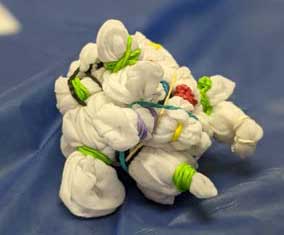
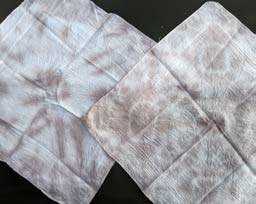 Living Innovations Homemaker group learned about blueberries in August by making homemade parfaits and all-natural dye. The group tie-dyed cotton handkerchiefs using various tools such as rubber bands, spray bottles, and cotton swabs to create interesting designs, then soaked their creations in a dye made from crushed organic blueberries.
Living Innovations Homemaker group learned about blueberries in August by making homemade parfaits and all-natural dye. The group tie-dyed cotton handkerchiefs using various tools such as rubber bands, spray bottles, and cotton swabs to create interesting designs, then soaked their creations in a dye made from crushed organic blueberries.
Aroostook County
Members of the Caribou Homemakers held their annual wreath-making meeting, where woodbine in harvested from the land of Lauretta Blackstone and turned into decorative wreaths that are given to a local realtor and presented to new homeowners in the Caribou area, with messages inviting new residents to join Extension.
Cumberland County
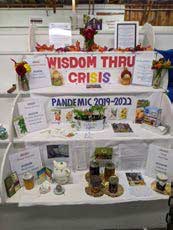 Cumberland County Extension Homemakers have been busy this summer with field trips and workshops. In September, members from four groups attended the Apple Canning Workshop that was held at the Falmouth Extension Office and taught by Master Food Preservers. Participants learned to make Spiced Dutch Apple Jam and used an electric water bath canner. The CCEH also put up a display at the fair and hosted a recruitment activity for fairgoers. The theme of the display was “Wisdom through Crisis” and used examples of various crises that have arisen over the past year and creative solutions that Homemakers used to successfully get through the hard times.
Cumberland County Extension Homemakers have been busy this summer with field trips and workshops. In September, members from four groups attended the Apple Canning Workshop that was held at the Falmouth Extension Office and taught by Master Food Preservers. Participants learned to make Spiced Dutch Apple Jam and used an electric water bath canner. The CCEH also put up a display at the fair and hosted a recruitment activity for fairgoers. The theme of the display was “Wisdom through Crisis” and used examples of various crises that have arisen over the past year and creative solutions that Homemakers used to successfully get through the hard times.
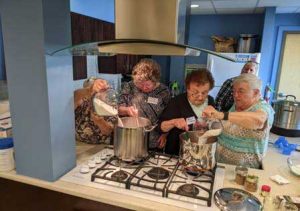
Hancock County
Homemakers in Hancock County took part in an Open House at the Extension Office in June, went on a field trip to Nervous Nellies Jams and Jellies, and enjoyed a tour of Nellieville on Deer Isle.
Oxford County
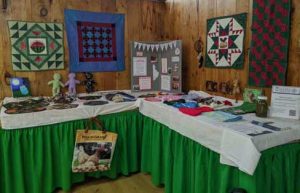 Another wonderful fair season for the Oxford County Extension Homemakers! County members brought crafts such as wool penny rugs, knitted hats, quilted wall hangings, and stuffed comfort dolls. Advisor Cathy Bartlett Gray hosted a recruitment activity that was designed by York County’s Modern Day Homemaker group.
Another wonderful fair season for the Oxford County Extension Homemakers! County members brought crafts such as wool penny rugs, knitted hats, quilted wall hangings, and stuffed comfort dolls. Advisor Cathy Bartlett Gray hosted a recruitment activity that was designed by York County’s Modern Day Homemaker group.
York County
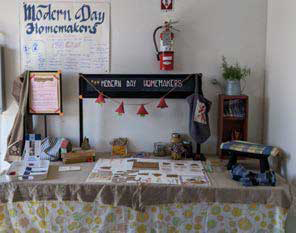
The Modern Day Homemakers held a meet-and-greet with Homemaker Advisor, Cathy Bartlett Gray at the Acton Fair. The MDH created a lovely and enticing display in the 4-H Exhibit Hall that had lots of information about how to become a member. While at the fair, Cathy helped with recruiting by demonstrating a make-and-take activity as a way to draw in fairgoers. Many thanks to MDH member, Catherine J. who designed the engaging activity called Herbal Cleaning Vinegar. It was a hit!
Avoiding Invasives in Harvest and Holiday Decorating
Wreaths and decorations containing natural materials is very popular in the fall and winter. The two most common invasive plants used in wreaths and garlands are Asiatic bittersweet and multiflora rose. Both plants cause severe environmental damage by invading open fields, forests, wetlands, meadows, and backyards and crowding out native plants.
- Asiatic Bittersweet (Maine.gov DACF) kills mature trees through strangling.
- Multiflora Rose (Maine.gov DACF) can form impenetrable thickets that outcompete native plant species.
Both species are difficult to control and easily resprout after cutting. The placement of invasive plant wreaths and garlands outdoors, or disposing of them in compost piles, can lead to new infestations. Birds and other animals eat the fruit and spread viable seeds into vulnerable forest areas.
Report It: Wreaths may not be sold that contain these or any invasive species. Report locations where banned plants are sold to the Maine Horticulture Program (www.maine.gov) or by calling 207.287.3891.
Habitat-Friendly Alternatives: “Look for decorations with native species in them like winterberry holly, red twig dogwood, or American mountain ash,” recommends Maine State Horticulturist Gary Fish.
Ways to Enjoy Autumn in the Outdoors
By Kate Garland, and reprinted from the November 2021 University of Maine Cooperative Extension Maine Home Garden Newsletter
- Visit a bog to enjoy the vibrant colors of pitcher plants, mosses, larch, and other water-loving plants growing in our native wetlands. The fall foliage show isn’t over! Don’t forget to bring your favorite field guide.
- Empty and rinse clay garden pots and store them upside down in a dry location. Leaving clay pots filled with soil over the winter can result in cracking and breakage.
- Collect natural items to add to holiday decorations. Scavenge wisely by only collecting from your own property or areas where you have permission. Also, be sure to not take more than you need or any items that appear to be rare or limited in the landscape.
- Take pictures of areas you want to redesign next year. Be sure to capture images from all perspectives (inside the house, the driveway, by the road, etc.) to account for the variety of ways you’ll be viewing and engaging in your landscape.
- Plant spring-flowering bulbs such as crocus, hyacinth, and snowdrops. It’s the perfect time to plant these outdoors and it’s a great time to pot up some bulbs for indoor forcing. Most bulbs need to be chilled in the refrigerator for about 12 weeks to stimulate flower development.
- Begin managing browntail moths by pruning out winter webs.
- Protect the base of young fruit trees from voles or mice by placing hardware cloth around the bottom 12-18 inches of the tree. Avoid keeping the barrier tight against the trunk and remove it in the spring. To deter larger animals from nibbling on your tree, an 8-foot fence and a bar of scented soap hanging from the limbs are very helpful.
Agricultural Fairs in 2022
- Fryeburg Fair: October 2-9
Gardening Tips for October, November, and December
Bringing Houseplants Inside After The Summer
Many people bring their houseplants outside over the summer to enjoy lots of warmth and sunshine. However, special care should be taken when bringing those same plants back inside once the weather turns cold. While some types of plants seem to do “ok” with sudden changes to light and temperature, others may protest by withering and losing their leaves. Here are some key things to keep in mind before you bring your plants inside.
- Watch the thermostat and pay attention to overnight low temperatures. You’ll want to make sure to move your houseplants inside before night temps get below 45°F. Any colder and you’re likely to see damage.
- Watch for pests on your houseplants before moving the inside. Some common pests are aphids, scale, and spider mites. Make sure to turn over leaves to check the undersides and look closely along the stems. Even if you don’t spot any bugs, wash off your plants with a strong spray of water from the hose for good measure.
- Transition gradually. Your houseplants will respond to gradual changes in daylight better than a sudden change. Start by putting your plants in shady places for a couple of weeks before bringing them inside. If your plants have gotten a little overgrown, this is a good time to trim them back a bit and remove any dead leaves so you can keep the mess outside.
- Put your houseplants on a diet. Once your plants are back inside, their need for fertilizer and water will be reduced. While they don’t go completely dormant, many houseplants slow their growth during the colder months, meaning they don’t need as much water or fertilizer as they did during the warm growing season. Refrain from fertilizing until spring, and water just enough so they don’t dry out completely.
- Give them what they want, just less of it. Even though your houseplants are in a semi-dormant state, they still need bright, indirect light. Some people use grow lights to supplement the amount of indirect light their plants get over the winter months. And while your plants don’t need as much watering, they do benefit from extra humidity, given that most heated homes have very dry air in winter. Mist your plants several times a week, or use a humidifier to provide extra moisture.
Meet Your County Advisory Team
What is the movie we can watch over and over and never tire of it?
- Angela: The Shawshank Redemption
- Cathy: The Princess Bride or Pride and Prejudice (1995 version)
- Lisa: The Wizard of Oz or The Big Chill
Mark Your Calendars
October 31: Enrollment Forms for 2023 submitted to County Office Support Staff and Angela Martin (Packets will be mailed to County Presidents in August)
November 7: MEHC Advisory Board Meeting; Packing and Wrapping Janet’s Jammies
November 9: Snow Date for MEHC Advisory Board Meeting
November 11: Veteran’s Day
October is National Chili Month and National Depression Education and Awareness Month, as well as National Book Month. To observe National Book Month, just pick up a book and make time to read! Reading is one of the best things you can do for your mental health. Reading improves vocabulary, spelling, and even memory, and is free entertainment.
October 7 is World Smile Day! Always observed the first Friday of October. On World Smile Day, people are encouraged to do an act of kindness that will make one person smile. In 1963 Harvey Ball, of Worcester, Massachusetts created the yellow smiley face as part of an ad campaign for an insurance company. Smiling improves mood, lowers blood pressure, relieves stress, boosts the immune system, relieves pain, and increases life expectancy. With so many benefits, it’s hard not to smile!
November is National Life Writing Month, sometimes called Memoir Writing Month. November is also National Spinach and Squash Month.
December 7 is Pearl Harbor Day
December 15 is National Wear Your Pearls Day-a national depression and anxiety awareness campaign
December 15 is also National Cat Herders Day
December 17 is National Wreaths Across America Day
In Honor of National Chili Month
Check out the “Vegetarian Chili” recipe from our UMaine Extension EFNEP program.
In Honor of National Squash Month
Check out the “Apple-Squash Casserole” recipe from our UMaine Extension EFNEP program.
What is This Tool?

Answer Key to Last Issue’s History Quiz
| Event | Year |
|---|---|
| Bureau of Investigation (FBI forerunner) was established: | 1908 |
| Charles Lindbergh makes the first solo nonstop transatlantic flight in his plane The Spirit of St. Louis: | 1927 |
| The year that the United Nations was established: | 1945 |
| The year that Puerto Rico becomes a U.S. commonwealth: | 1952 |
| Rev. Martin Luther King, Jr., delivers his “I Have a Dream” speech before a crowd of 200,000 during the civil rights march on Washington, DC: | 1963 |
| The bombing of federal office building in Oklahoma City kills 168 people: | 1995 |
| The Barcode was invented. The first product to use the barcode technology was a 10-pack Wrigley’s Juicy Fruit Chewing gum that was scanned at a grocery store in Ohio: | 1974 |
| The crossword puzzle invented by Arthur Wynne: | 1913 |
| Artificial life begins — the first robot built: | 1921 |
| The pop-up toaster invented by Charles Strite: | 1919 |
Information in this publication is provided purely for educational purposes. No responsibility is assumed for any problems associated with the use of products or services mentioned. No endorsement of products or companies is intended, nor is criticism of unnamed products or companies implied.
© 2022
Call 800.287.0274 (in Maine), or 207.581.3188, for information on publications and program offerings from University of Maine Cooperative Extension, or visit extension.umaine.edu.
The University of Maine is an EEO/AA employer and does not discriminate on the grounds of race, color, religion, sex, sexual orientation, transgender status, gender expression, national origin, citizenship status, age, disability, genetic information, or veteran’s status in employment, education, and all other programs and activities. The following person has been designated to handle inquiries regarding non-discrimination policies: Director of Equal Opportunity, 101 North Stevens Hall, University of Maine, Orono, ME 04469-5754, 207.581.1226, TTY 711 (Maine Relay System).

